Social Psychology Report: Analyzing Social Influence in Behavior
VerifiedAdded on 2022/08/30
|13
|2975
|33
Report
AI Summary
This report delves into core concepts of social psychology, examining obedience, conformity, and social influence within a specific context of children and young people, as well as in real-world scenarios. Task 1 presents an advisory report for a children's home, outlining measures to increase obedience and conformity through various psychological principles, including punishment, environmental influence, and reward systems. Task 2 explores the bystander effect through the Kitty Genovese case, analyzing how the presence of others can inhibit helping behavior. The report also discusses decision-making abilities in crisis situations, using the Sutton Coldfield rail crash as an example. It concludes with an evaluation of the validity of social influence theory concerning bystander influence and decision-making processes. The report draws on established psychological theories and research, offering recommendations for practical applications and a deeper understanding of social dynamics.
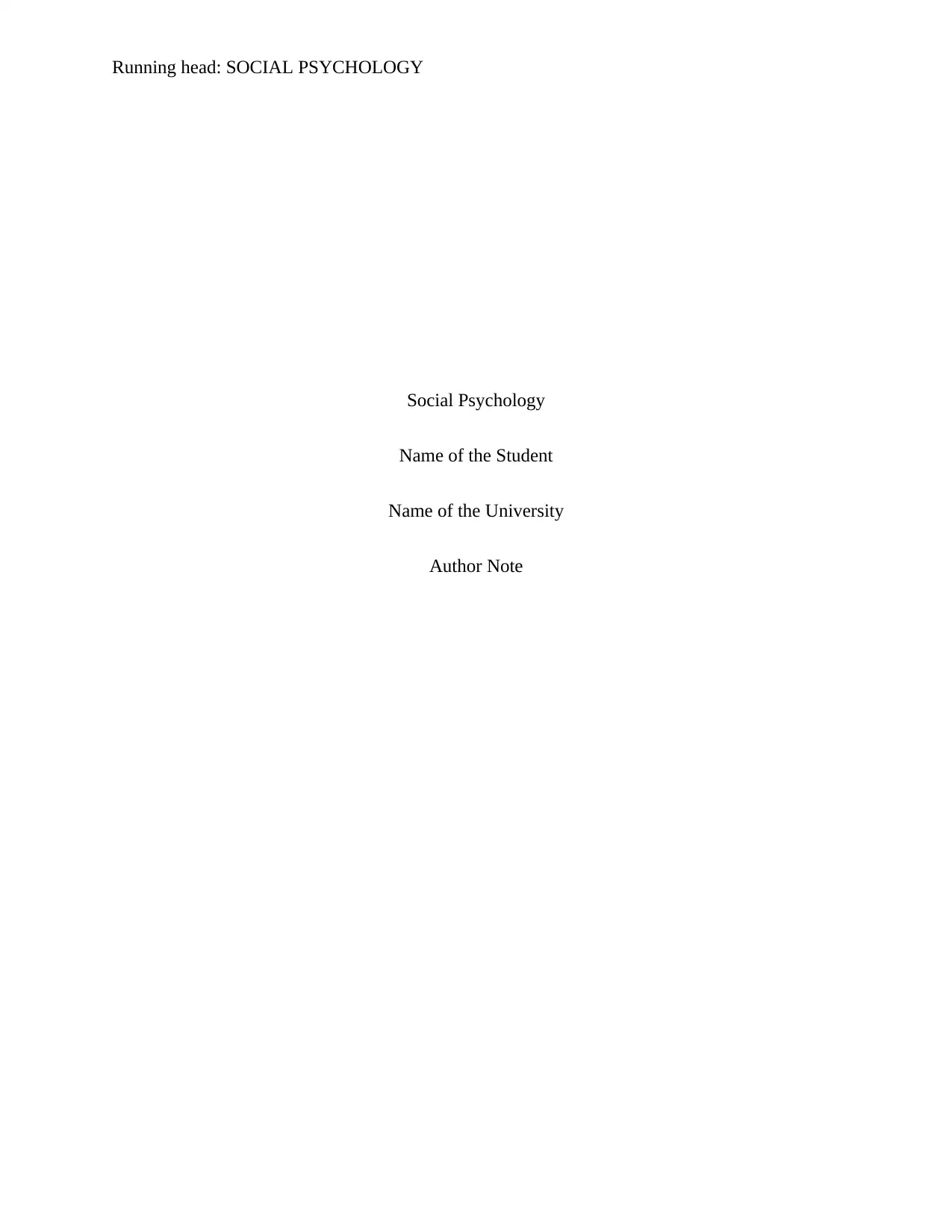
Running head: SOCIAL PSYCHOLOGY
Social Psychology
Name of the Student
Name of the University
Author Note
Social Psychology
Name of the Student
Name of the University
Author Note
Paraphrase This Document
Need a fresh take? Get an instant paraphrase of this document with our AI Paraphraser
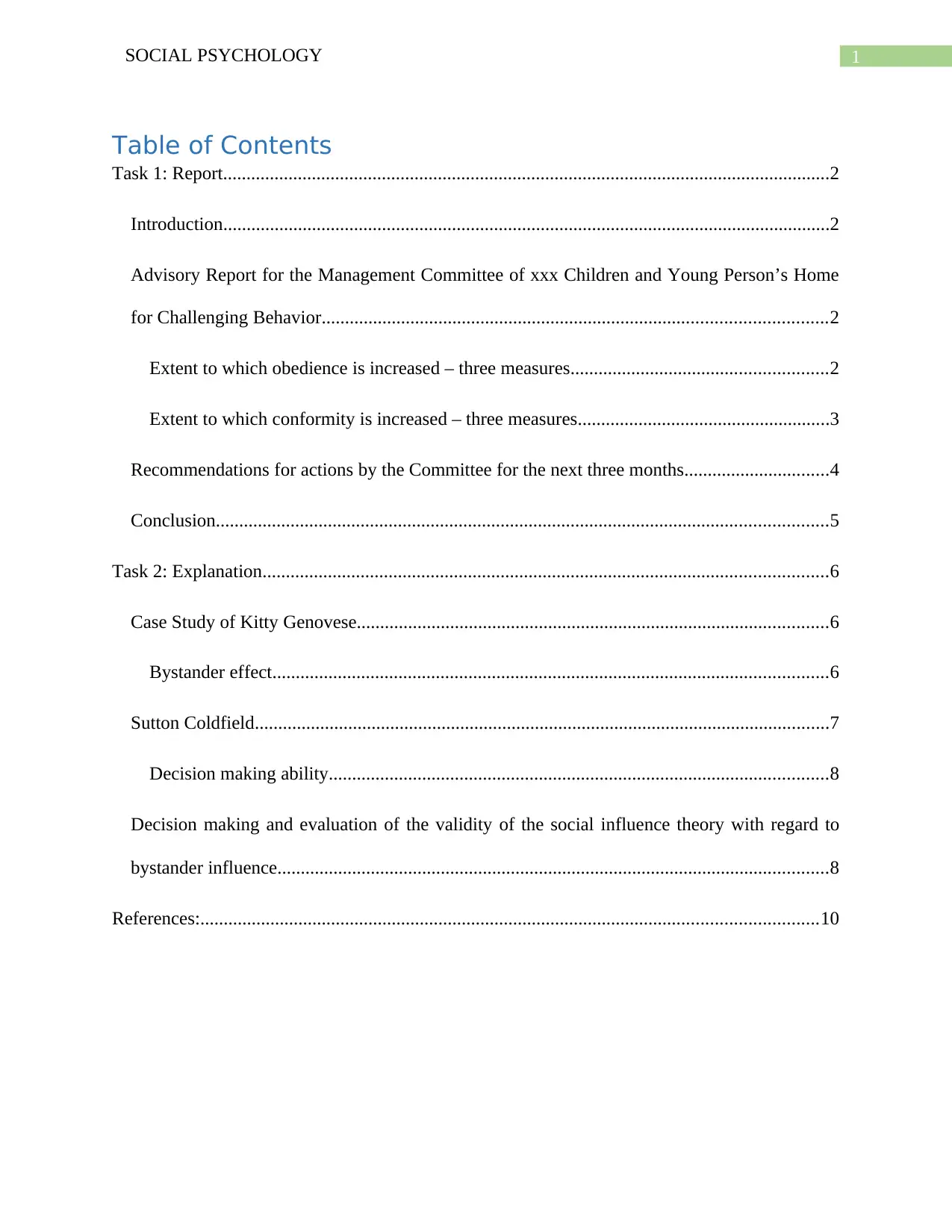
1SOCIAL PSYCHOLOGY
Table of Contents
Task 1: Report..................................................................................................................................2
Introduction..................................................................................................................................2
Advisory Report for the Management Committee of xxx Children and Young Person’s Home
for Challenging Behavior............................................................................................................2
Extent to which obedience is increased – three measures.......................................................2
Extent to which conformity is increased – three measures......................................................3
Recommendations for actions by the Committee for the next three months...............................4
Conclusion...................................................................................................................................5
Task 2: Explanation.........................................................................................................................6
Case Study of Kitty Genovese.....................................................................................................6
Bystander effect.......................................................................................................................6
Sutton Coldfield...........................................................................................................................7
Decision making ability...........................................................................................................8
Decision making and evaluation of the validity of the social influence theory with regard to
bystander influence......................................................................................................................8
References:....................................................................................................................................10
Table of Contents
Task 1: Report..................................................................................................................................2
Introduction..................................................................................................................................2
Advisory Report for the Management Committee of xxx Children and Young Person’s Home
for Challenging Behavior............................................................................................................2
Extent to which obedience is increased – three measures.......................................................2
Extent to which conformity is increased – three measures......................................................3
Recommendations for actions by the Committee for the next three months...............................4
Conclusion...................................................................................................................................5
Task 2: Explanation.........................................................................................................................6
Case Study of Kitty Genovese.....................................................................................................6
Bystander effect.......................................................................................................................6
Sutton Coldfield...........................................................................................................................7
Decision making ability...........................................................................................................8
Decision making and evaluation of the validity of the social influence theory with regard to
bystander influence......................................................................................................................8
References:....................................................................................................................................10
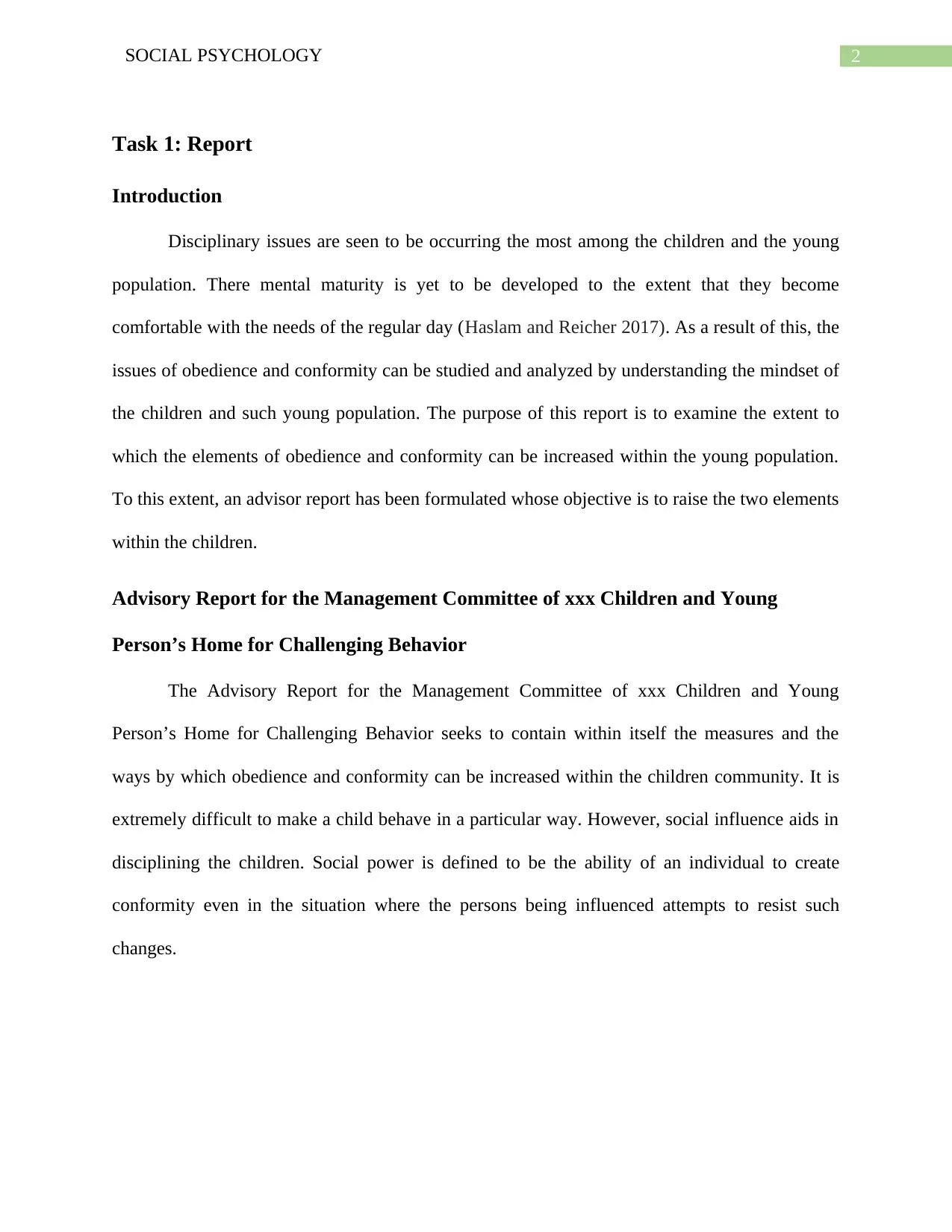
2SOCIAL PSYCHOLOGY
Task 1: Report
Introduction
Disciplinary issues are seen to be occurring the most among the children and the young
population. There mental maturity is yet to be developed to the extent that they become
comfortable with the needs of the regular day (Haslam and Reicher 2017). As a result of this, the
issues of obedience and conformity can be studied and analyzed by understanding the mindset of
the children and such young population. The purpose of this report is to examine the extent to
which the elements of obedience and conformity can be increased within the young population.
To this extent, an advisor report has been formulated whose objective is to raise the two elements
within the children.
Advisory Report for the Management Committee of xxx Children and Young
Person’s Home for Challenging Behavior
The Advisory Report for the Management Committee of xxx Children and Young
Person’s Home for Challenging Behavior seeks to contain within itself the measures and the
ways by which obedience and conformity can be increased within the children community. It is
extremely difficult to make a child behave in a particular way. However, social influence aids in
disciplining the children. Social power is defined to be the ability of an individual to create
conformity even in the situation where the persons being influenced attempts to resist such
changes.
Task 1: Report
Introduction
Disciplinary issues are seen to be occurring the most among the children and the young
population. There mental maturity is yet to be developed to the extent that they become
comfortable with the needs of the regular day (Haslam and Reicher 2017). As a result of this, the
issues of obedience and conformity can be studied and analyzed by understanding the mindset of
the children and such young population. The purpose of this report is to examine the extent to
which the elements of obedience and conformity can be increased within the young population.
To this extent, an advisor report has been formulated whose objective is to raise the two elements
within the children.
Advisory Report for the Management Committee of xxx Children and Young
Person’s Home for Challenging Behavior
The Advisory Report for the Management Committee of xxx Children and Young
Person’s Home for Challenging Behavior seeks to contain within itself the measures and the
ways by which obedience and conformity can be increased within the children community. It is
extremely difficult to make a child behave in a particular way. However, social influence aids in
disciplining the children. Social power is defined to be the ability of an individual to create
conformity even in the situation where the persons being influenced attempts to resist such
changes.
⊘ This is a preview!⊘
Do you want full access?
Subscribe today to unlock all pages.

Trusted by 1+ million students worldwide
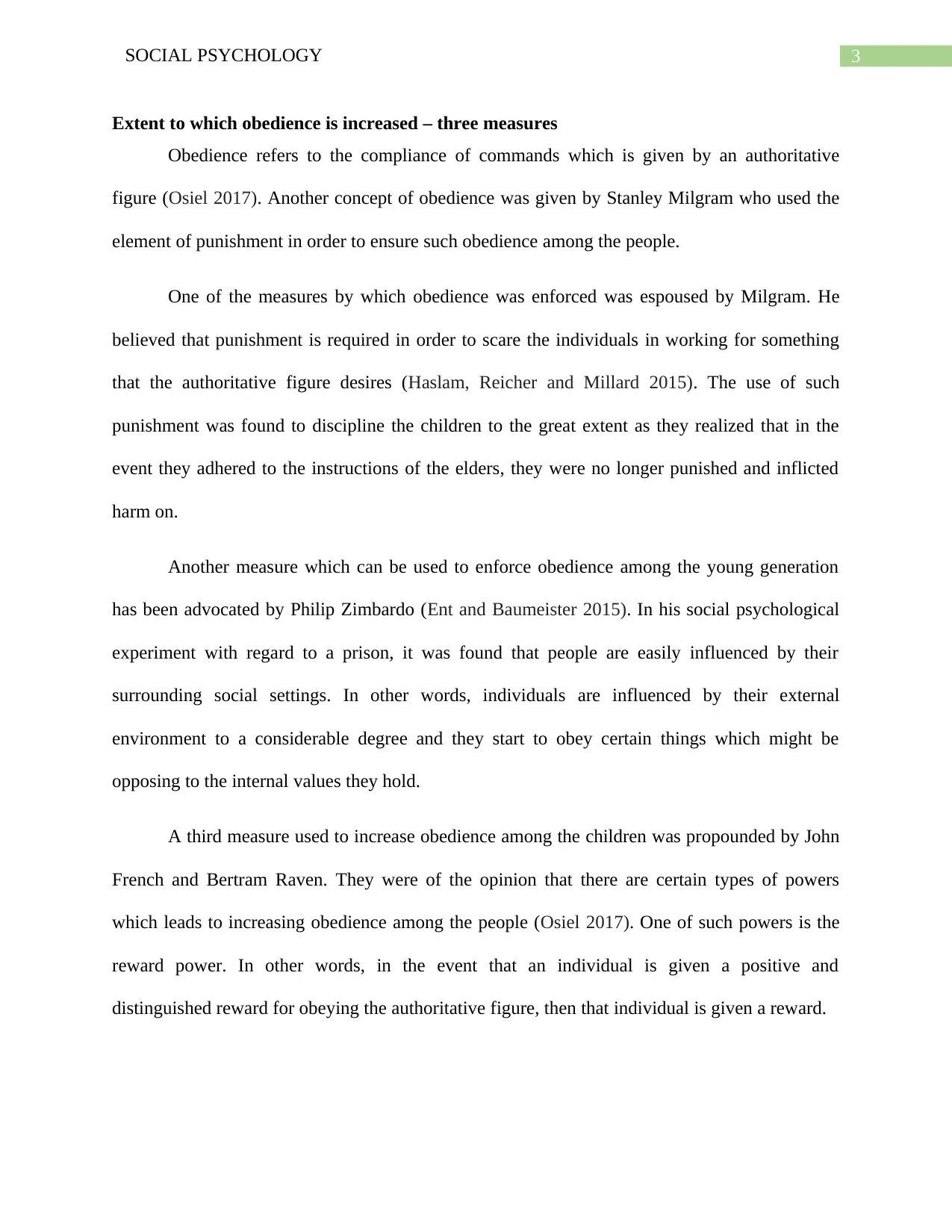
3SOCIAL PSYCHOLOGY
Extent to which obedience is increased – three measures
Obedience refers to the compliance of commands which is given by an authoritative
figure (Osiel 2017). Another concept of obedience was given by Stanley Milgram who used the
element of punishment in order to ensure such obedience among the people.
One of the measures by which obedience was enforced was espoused by Milgram. He
believed that punishment is required in order to scare the individuals in working for something
that the authoritative figure desires (Haslam, Reicher and Millard 2015). The use of such
punishment was found to discipline the children to the great extent as they realized that in the
event they adhered to the instructions of the elders, they were no longer punished and inflicted
harm on.
Another measure which can be used to enforce obedience among the young generation
has been advocated by Philip Zimbardo (Ent and Baumeister 2015). In his social psychological
experiment with regard to a prison, it was found that people are easily influenced by their
surrounding social settings. In other words, individuals are influenced by their external
environment to a considerable degree and they start to obey certain things which might be
opposing to the internal values they hold.
A third measure used to increase obedience among the children was propounded by John
French and Bertram Raven. They were of the opinion that there are certain types of powers
which leads to increasing obedience among the people (Osiel 2017). One of such powers is the
reward power. In other words, in the event that an individual is given a positive and
distinguished reward for obeying the authoritative figure, then that individual is given a reward.
Extent to which obedience is increased – three measures
Obedience refers to the compliance of commands which is given by an authoritative
figure (Osiel 2017). Another concept of obedience was given by Stanley Milgram who used the
element of punishment in order to ensure such obedience among the people.
One of the measures by which obedience was enforced was espoused by Milgram. He
believed that punishment is required in order to scare the individuals in working for something
that the authoritative figure desires (Haslam, Reicher and Millard 2015). The use of such
punishment was found to discipline the children to the great extent as they realized that in the
event they adhered to the instructions of the elders, they were no longer punished and inflicted
harm on.
Another measure which can be used to enforce obedience among the young generation
has been advocated by Philip Zimbardo (Ent and Baumeister 2015). In his social psychological
experiment with regard to a prison, it was found that people are easily influenced by their
surrounding social settings. In other words, individuals are influenced by their external
environment to a considerable degree and they start to obey certain things which might be
opposing to the internal values they hold.
A third measure used to increase obedience among the children was propounded by John
French and Bertram Raven. They were of the opinion that there are certain types of powers
which leads to increasing obedience among the people (Osiel 2017). One of such powers is the
reward power. In other words, in the event that an individual is given a positive and
distinguished reward for obeying the authoritative figure, then that individual is given a reward.
Paraphrase This Document
Need a fresh take? Get an instant paraphrase of this document with our AI Paraphraser
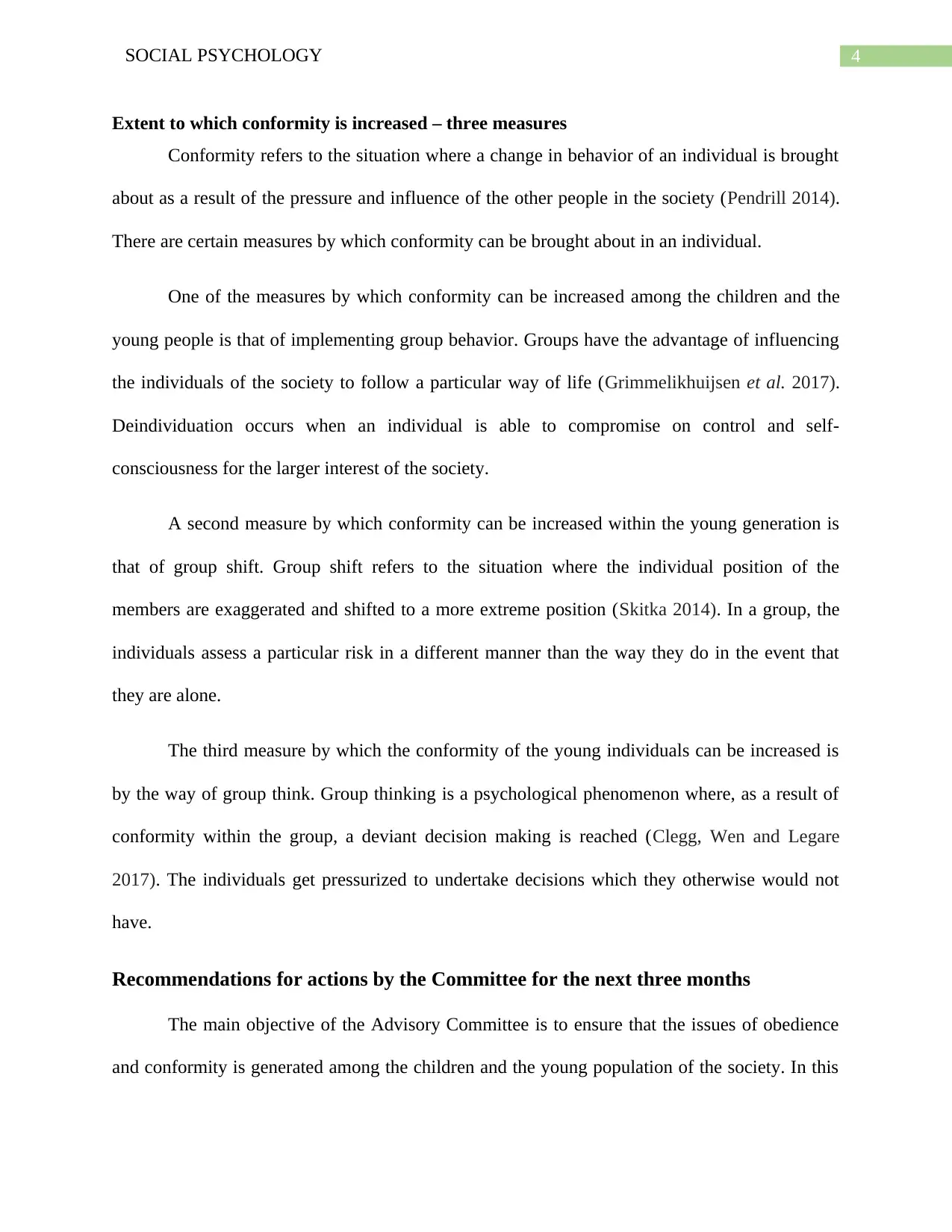
4SOCIAL PSYCHOLOGY
Extent to which conformity is increased – three measures
Conformity refers to the situation where a change in behavior of an individual is brought
about as a result of the pressure and influence of the other people in the society (Pendrill 2014).
There are certain measures by which conformity can be brought about in an individual.
One of the measures by which conformity can be increased among the children and the
young people is that of implementing group behavior. Groups have the advantage of influencing
the individuals of the society to follow a particular way of life (Grimmelikhuijsen et al. 2017).
Deindividuation occurs when an individual is able to compromise on control and self-
consciousness for the larger interest of the society.
A second measure by which conformity can be increased within the young generation is
that of group shift. Group shift refers to the situation where the individual position of the
members are exaggerated and shifted to a more extreme position (Skitka 2014). In a group, the
individuals assess a particular risk in a different manner than the way they do in the event that
they are alone.
The third measure by which the conformity of the young individuals can be increased is
by the way of group think. Group thinking is a psychological phenomenon where, as a result of
conformity within the group, a deviant decision making is reached (Clegg, Wen and Legare
2017). The individuals get pressurized to undertake decisions which they otherwise would not
have.
Recommendations for actions by the Committee for the next three months
The main objective of the Advisory Committee is to ensure that the issues of obedience
and conformity is generated among the children and the young population of the society. In this
Extent to which conformity is increased – three measures
Conformity refers to the situation where a change in behavior of an individual is brought
about as a result of the pressure and influence of the other people in the society (Pendrill 2014).
There are certain measures by which conformity can be brought about in an individual.
One of the measures by which conformity can be increased among the children and the
young people is that of implementing group behavior. Groups have the advantage of influencing
the individuals of the society to follow a particular way of life (Grimmelikhuijsen et al. 2017).
Deindividuation occurs when an individual is able to compromise on control and self-
consciousness for the larger interest of the society.
A second measure by which conformity can be increased within the young generation is
that of group shift. Group shift refers to the situation where the individual position of the
members are exaggerated and shifted to a more extreme position (Skitka 2014). In a group, the
individuals assess a particular risk in a different manner than the way they do in the event that
they are alone.
The third measure by which the conformity of the young individuals can be increased is
by the way of group think. Group thinking is a psychological phenomenon where, as a result of
conformity within the group, a deviant decision making is reached (Clegg, Wen and Legare
2017). The individuals get pressurized to undertake decisions which they otherwise would not
have.
Recommendations for actions by the Committee for the next three months
The main objective of the Advisory Committee is to ensure that the issues of obedience
and conformity is generated among the children and the young population of the society. In this
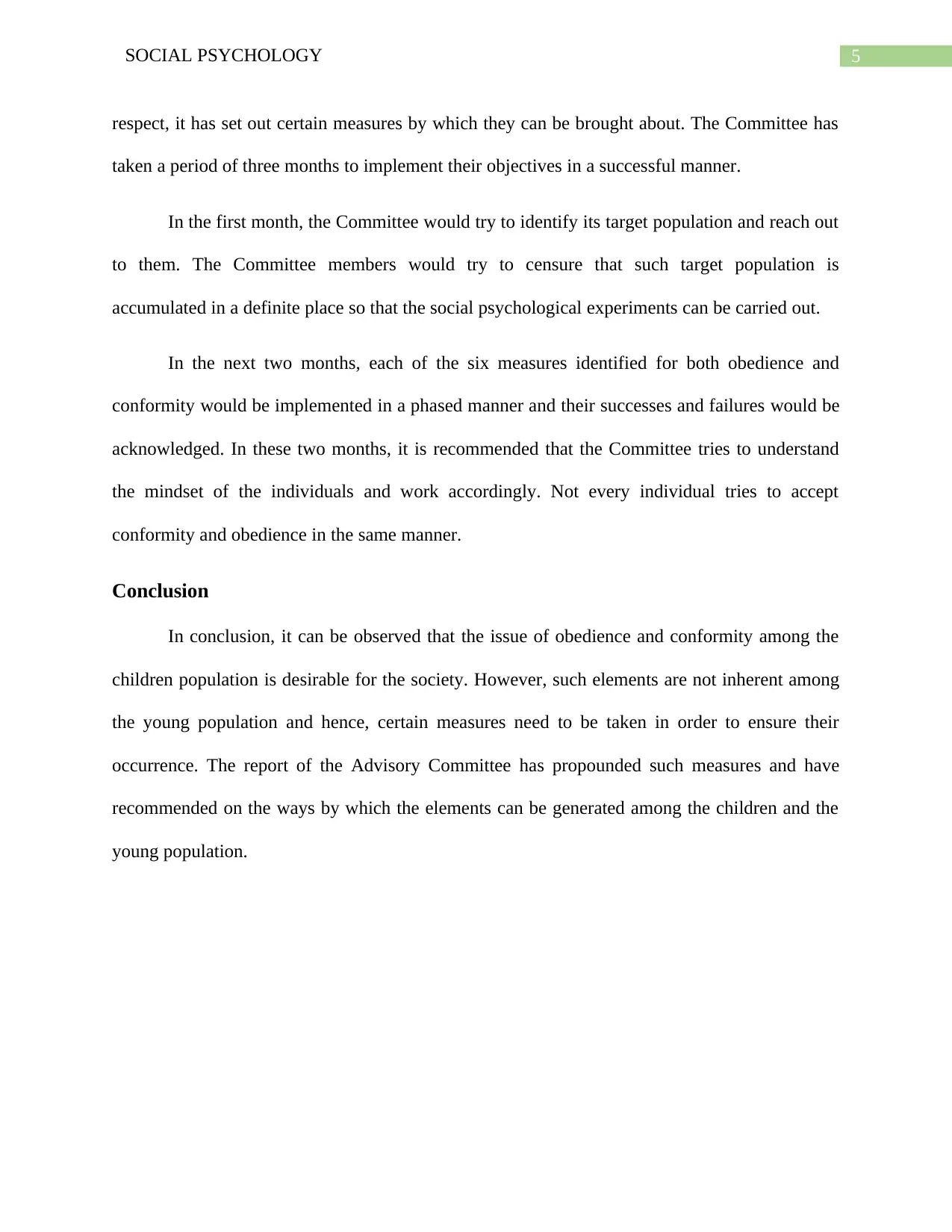
5SOCIAL PSYCHOLOGY
respect, it has set out certain measures by which they can be brought about. The Committee has
taken a period of three months to implement their objectives in a successful manner.
In the first month, the Committee would try to identify its target population and reach out
to them. The Committee members would try to censure that such target population is
accumulated in a definite place so that the social psychological experiments can be carried out.
In the next two months, each of the six measures identified for both obedience and
conformity would be implemented in a phased manner and their successes and failures would be
acknowledged. In these two months, it is recommended that the Committee tries to understand
the mindset of the individuals and work accordingly. Not every individual tries to accept
conformity and obedience in the same manner.
Conclusion
In conclusion, it can be observed that the issue of obedience and conformity among the
children population is desirable for the society. However, such elements are not inherent among
the young population and hence, certain measures need to be taken in order to ensure their
occurrence. The report of the Advisory Committee has propounded such measures and have
recommended on the ways by which the elements can be generated among the children and the
young population.
respect, it has set out certain measures by which they can be brought about. The Committee has
taken a period of three months to implement their objectives in a successful manner.
In the first month, the Committee would try to identify its target population and reach out
to them. The Committee members would try to censure that such target population is
accumulated in a definite place so that the social psychological experiments can be carried out.
In the next two months, each of the six measures identified for both obedience and
conformity would be implemented in a phased manner and their successes and failures would be
acknowledged. In these two months, it is recommended that the Committee tries to understand
the mindset of the individuals and work accordingly. Not every individual tries to accept
conformity and obedience in the same manner.
Conclusion
In conclusion, it can be observed that the issue of obedience and conformity among the
children population is desirable for the society. However, such elements are not inherent among
the young population and hence, certain measures need to be taken in order to ensure their
occurrence. The report of the Advisory Committee has propounded such measures and have
recommended on the ways by which the elements can be generated among the children and the
young population.
⊘ This is a preview!⊘
Do you want full access?
Subscribe today to unlock all pages.

Trusted by 1+ million students worldwide
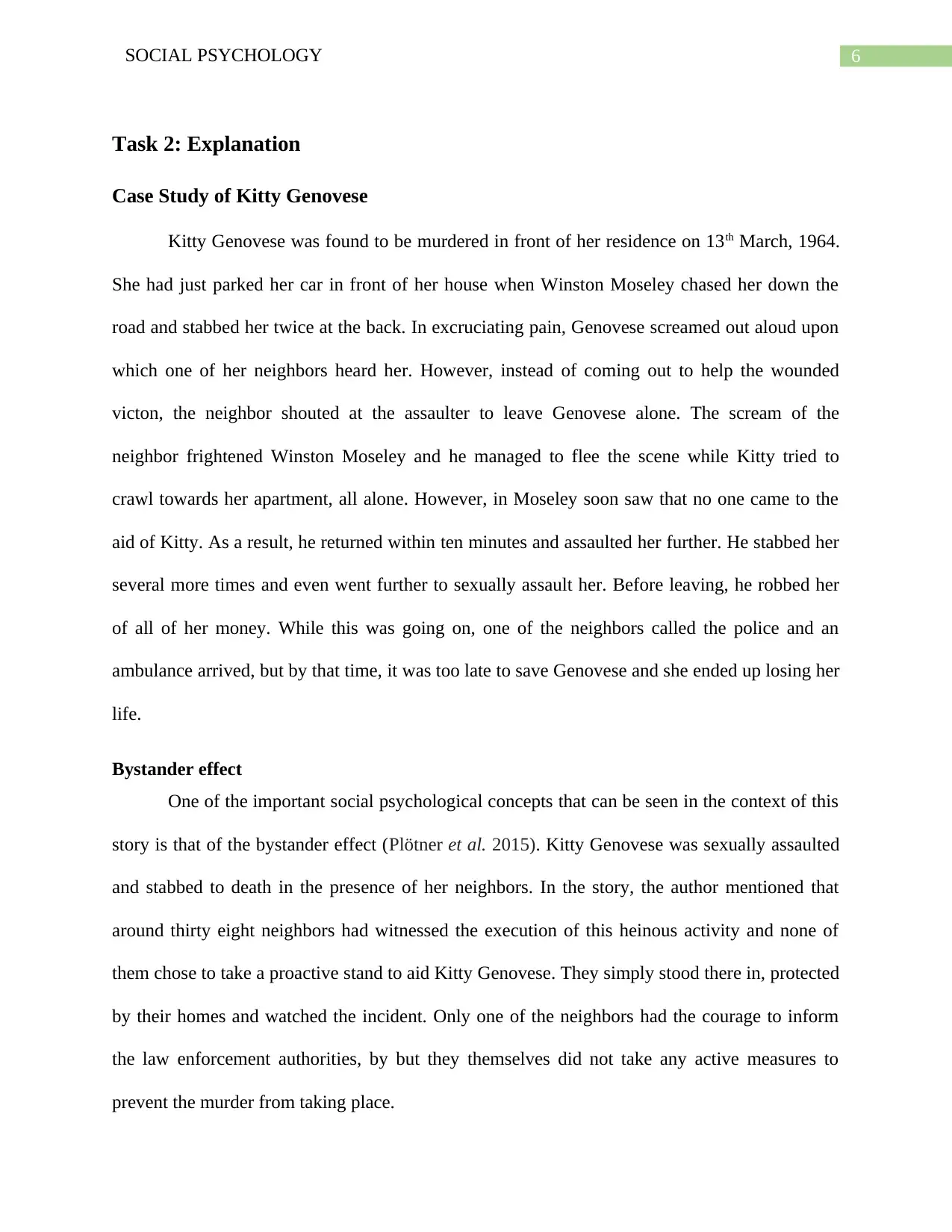
6SOCIAL PSYCHOLOGY
Task 2: Explanation
Case Study of Kitty Genovese
Kitty Genovese was found to be murdered in front of her residence on 13th March, 1964.
She had just parked her car in front of her house when Winston Moseley chased her down the
road and stabbed her twice at the back. In excruciating pain, Genovese screamed out aloud upon
which one of her neighbors heard her. However, instead of coming out to help the wounded
victon, the neighbor shouted at the assaulter to leave Genovese alone. The scream of the
neighbor frightened Winston Moseley and he managed to flee the scene while Kitty tried to
crawl towards her apartment, all alone. However, in Moseley soon saw that no one came to the
aid of Kitty. As a result, he returned within ten minutes and assaulted her further. He stabbed her
several more times and even went further to sexually assault her. Before leaving, he robbed her
of all of her money. While this was going on, one of the neighbors called the police and an
ambulance arrived, but by that time, it was too late to save Genovese and she ended up losing her
life.
Bystander effect
One of the important social psychological concepts that can be seen in the context of this
story is that of the bystander effect (Plötner et al. 2015). Kitty Genovese was sexually assaulted
and stabbed to death in the presence of her neighbors. In the story, the author mentioned that
around thirty eight neighbors had witnessed the execution of this heinous activity and none of
them chose to take a proactive stand to aid Kitty Genovese. They simply stood there in, protected
by their homes and watched the incident. Only one of the neighbors had the courage to inform
the law enforcement authorities, by but they themselves did not take any active measures to
prevent the murder from taking place.
Task 2: Explanation
Case Study of Kitty Genovese
Kitty Genovese was found to be murdered in front of her residence on 13th March, 1964.
She had just parked her car in front of her house when Winston Moseley chased her down the
road and stabbed her twice at the back. In excruciating pain, Genovese screamed out aloud upon
which one of her neighbors heard her. However, instead of coming out to help the wounded
victon, the neighbor shouted at the assaulter to leave Genovese alone. The scream of the
neighbor frightened Winston Moseley and he managed to flee the scene while Kitty tried to
crawl towards her apartment, all alone. However, in Moseley soon saw that no one came to the
aid of Kitty. As a result, he returned within ten minutes and assaulted her further. He stabbed her
several more times and even went further to sexually assault her. Before leaving, he robbed her
of all of her money. While this was going on, one of the neighbors called the police and an
ambulance arrived, but by that time, it was too late to save Genovese and she ended up losing her
life.
Bystander effect
One of the important social psychological concepts that can be seen in the context of this
story is that of the bystander effect (Plötner et al. 2015). Kitty Genovese was sexually assaulted
and stabbed to death in the presence of her neighbors. In the story, the author mentioned that
around thirty eight neighbors had witnessed the execution of this heinous activity and none of
them chose to take a proactive stand to aid Kitty Genovese. They simply stood there in, protected
by their homes and watched the incident. Only one of the neighbors had the courage to inform
the law enforcement authorities, by but they themselves did not take any active measures to
prevent the murder from taking place.
Paraphrase This Document
Need a fresh take? Get an instant paraphrase of this document with our AI Paraphraser
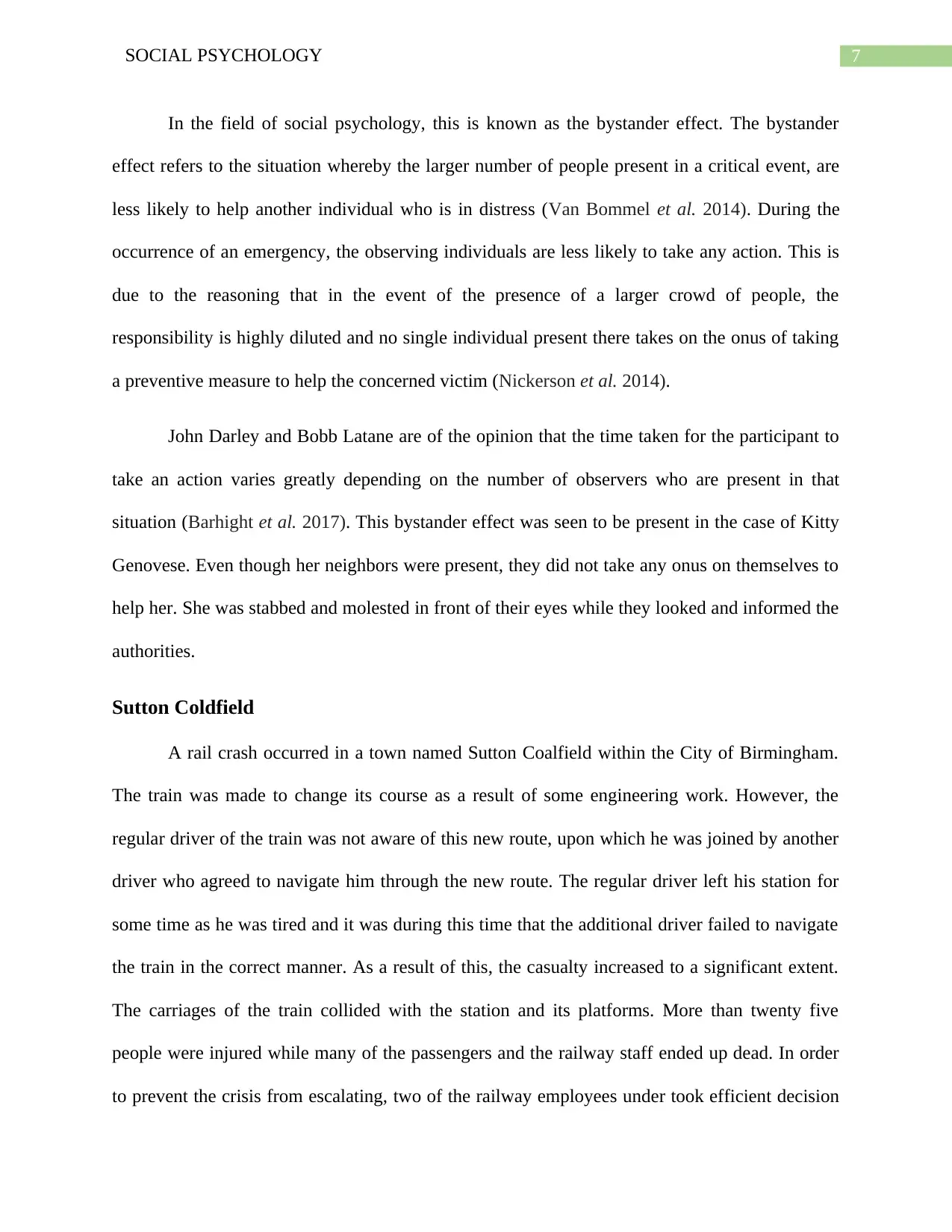
7SOCIAL PSYCHOLOGY
In the field of social psychology, this is known as the bystander effect. The bystander
effect refers to the situation whereby the larger number of people present in a critical event, are
less likely to help another individual who is in distress (Van Bommel et al. 2014). During the
occurrence of an emergency, the observing individuals are less likely to take any action. This is
due to the reasoning that in the event of the presence of a larger crowd of people, the
responsibility is highly diluted and no single individual present there takes on the onus of taking
a preventive measure to help the concerned victim (Nickerson et al. 2014).
John Darley and Bobb Latane are of the opinion that the time taken for the participant to
take an action varies greatly depending on the number of observers who are present in that
situation (Barhight et al. 2017). This bystander effect was seen to be present in the case of Kitty
Genovese. Even though her neighbors were present, they did not take any onus on themselves to
help her. She was stabbed and molested in front of their eyes while they looked and informed the
authorities.
Sutton Coldfield
A rail crash occurred in a town named Sutton Coalfield within the City of Birmingham.
The train was made to change its course as a result of some engineering work. However, the
regular driver of the train was not aware of this new route, upon which he was joined by another
driver who agreed to navigate him through the new route. The regular driver left his station for
some time as he was tired and it was during this time that the additional driver failed to navigate
the train in the correct manner. As a result of this, the casualty increased to a significant extent.
The carriages of the train collided with the station and its platforms. More than twenty five
people were injured while many of the passengers and the railway staff ended up dead. In order
to prevent the crisis from escalating, two of the railway employees under took efficient decision
In the field of social psychology, this is known as the bystander effect. The bystander
effect refers to the situation whereby the larger number of people present in a critical event, are
less likely to help another individual who is in distress (Van Bommel et al. 2014). During the
occurrence of an emergency, the observing individuals are less likely to take any action. This is
due to the reasoning that in the event of the presence of a larger crowd of people, the
responsibility is highly diluted and no single individual present there takes on the onus of taking
a preventive measure to help the concerned victim (Nickerson et al. 2014).
John Darley and Bobb Latane are of the opinion that the time taken for the participant to
take an action varies greatly depending on the number of observers who are present in that
situation (Barhight et al. 2017). This bystander effect was seen to be present in the case of Kitty
Genovese. Even though her neighbors were present, they did not take any onus on themselves to
help her. She was stabbed and molested in front of their eyes while they looked and informed the
authorities.
Sutton Coldfield
A rail crash occurred in a town named Sutton Coalfield within the City of Birmingham.
The train was made to change its course as a result of some engineering work. However, the
regular driver of the train was not aware of this new route, upon which he was joined by another
driver who agreed to navigate him through the new route. The regular driver left his station for
some time as he was tired and it was during this time that the additional driver failed to navigate
the train in the correct manner. As a result of this, the casualty increased to a significant extent.
The carriages of the train collided with the station and its platforms. More than twenty five
people were injured while many of the passengers and the railway staff ended up dead. In order
to prevent the crisis from escalating, two of the railway employees under took efficient decision
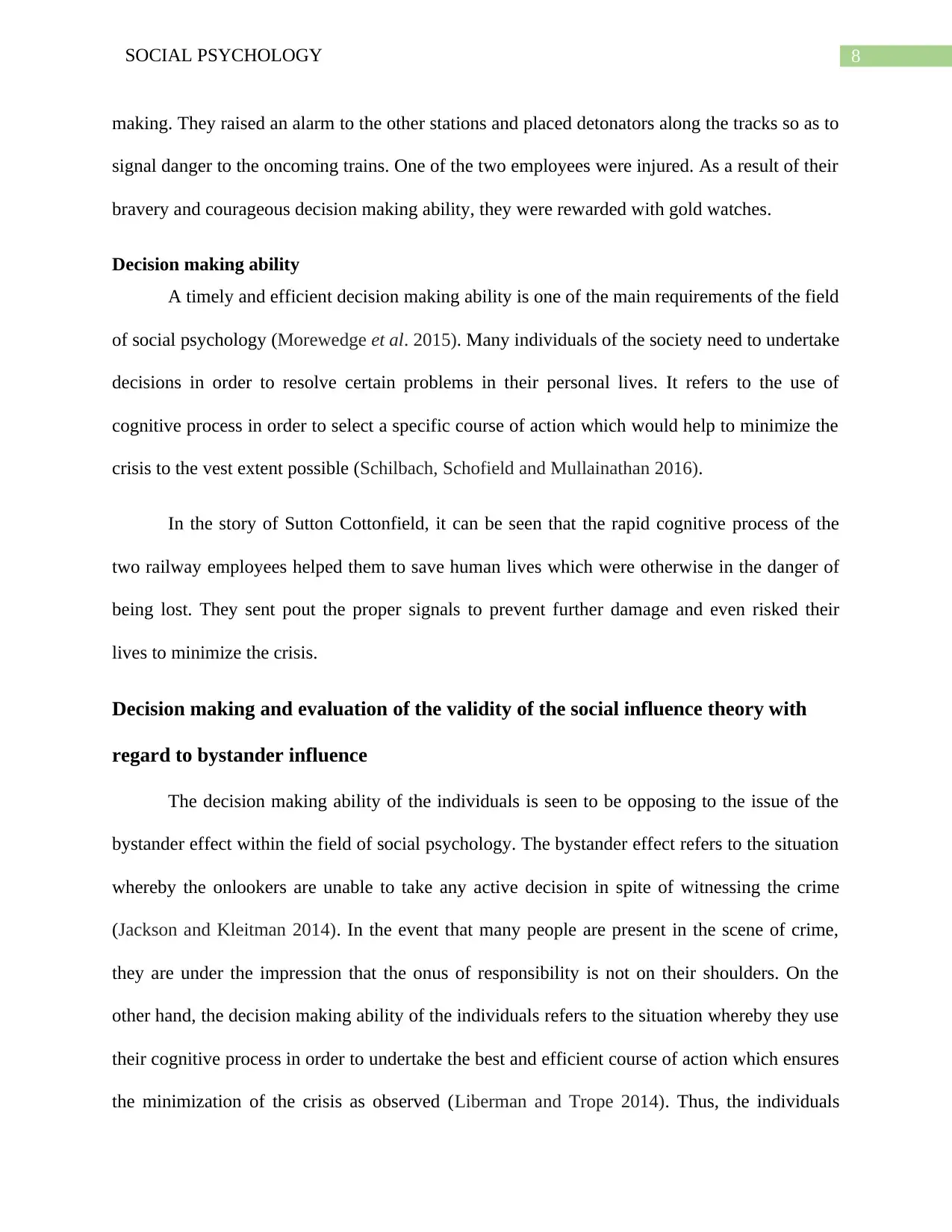
8SOCIAL PSYCHOLOGY
making. They raised an alarm to the other stations and placed detonators along the tracks so as to
signal danger to the oncoming trains. One of the two employees were injured. As a result of their
bravery and courageous decision making ability, they were rewarded with gold watches.
Decision making ability
A timely and efficient decision making ability is one of the main requirements of the field
of social psychology (Morewedge et al. 2015). Many individuals of the society need to undertake
decisions in order to resolve certain problems in their personal lives. It refers to the use of
cognitive process in order to select a specific course of action which would help to minimize the
crisis to the vest extent possible (Schilbach, Schofield and Mullainathan 2016).
In the story of Sutton Cottonfield, it can be seen that the rapid cognitive process of the
two railway employees helped them to save human lives which were otherwise in the danger of
being lost. They sent pout the proper signals to prevent further damage and even risked their
lives to minimize the crisis.
Decision making and evaluation of the validity of the social influence theory with
regard to bystander influence
The decision making ability of the individuals is seen to be opposing to the issue of the
bystander effect within the field of social psychology. The bystander effect refers to the situation
whereby the onlookers are unable to take any active decision in spite of witnessing the crime
(Jackson and Kleitman 2014). In the event that many people are present in the scene of crime,
they are under the impression that the onus of responsibility is not on their shoulders. On the
other hand, the decision making ability of the individuals refers to the situation whereby they use
their cognitive process in order to undertake the best and efficient course of action which ensures
the minimization of the crisis as observed (Liberman and Trope 2014). Thus, the individuals
making. They raised an alarm to the other stations and placed detonators along the tracks so as to
signal danger to the oncoming trains. One of the two employees were injured. As a result of their
bravery and courageous decision making ability, they were rewarded with gold watches.
Decision making ability
A timely and efficient decision making ability is one of the main requirements of the field
of social psychology (Morewedge et al. 2015). Many individuals of the society need to undertake
decisions in order to resolve certain problems in their personal lives. It refers to the use of
cognitive process in order to select a specific course of action which would help to minimize the
crisis to the vest extent possible (Schilbach, Schofield and Mullainathan 2016).
In the story of Sutton Cottonfield, it can be seen that the rapid cognitive process of the
two railway employees helped them to save human lives which were otherwise in the danger of
being lost. They sent pout the proper signals to prevent further damage and even risked their
lives to minimize the crisis.
Decision making and evaluation of the validity of the social influence theory with
regard to bystander influence
The decision making ability of the individuals is seen to be opposing to the issue of the
bystander effect within the field of social psychology. The bystander effect refers to the situation
whereby the onlookers are unable to take any active decision in spite of witnessing the crime
(Jackson and Kleitman 2014). In the event that many people are present in the scene of crime,
they are under the impression that the onus of responsibility is not on their shoulders. On the
other hand, the decision making ability of the individuals refers to the situation whereby they use
their cognitive process in order to undertake the best and efficient course of action which ensures
the minimization of the crisis as observed (Liberman and Trope 2014). Thus, the individuals
⊘ This is a preview!⊘
Do you want full access?
Subscribe today to unlock all pages.

Trusted by 1+ million students worldwide
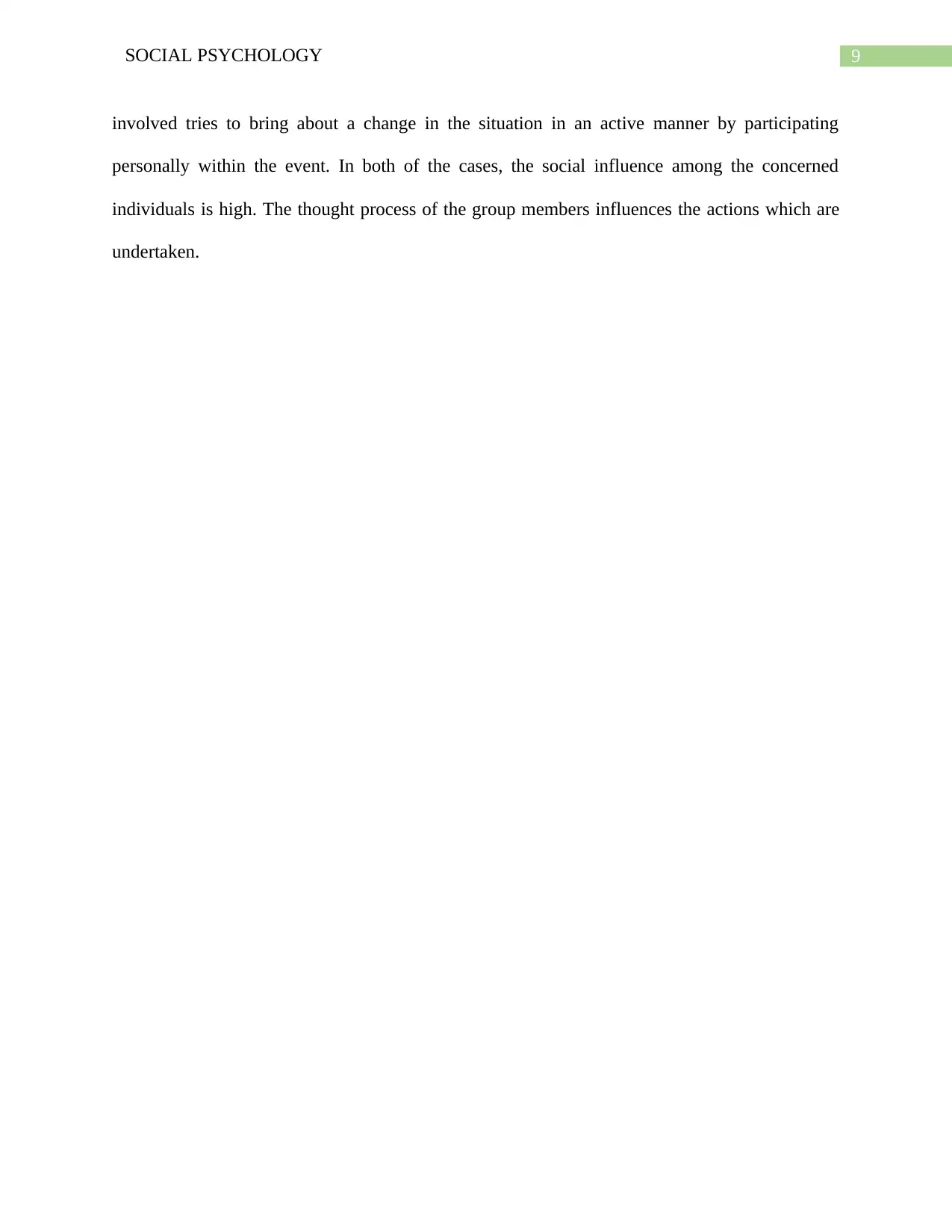
9SOCIAL PSYCHOLOGY
involved tries to bring about a change in the situation in an active manner by participating
personally within the event. In both of the cases, the social influence among the concerned
individuals is high. The thought process of the group members influences the actions which are
undertaken.
involved tries to bring about a change in the situation in an active manner by participating
personally within the event. In both of the cases, the social influence among the concerned
individuals is high. The thought process of the group members influences the actions which are
undertaken.
Paraphrase This Document
Need a fresh take? Get an instant paraphrase of this document with our AI Paraphraser
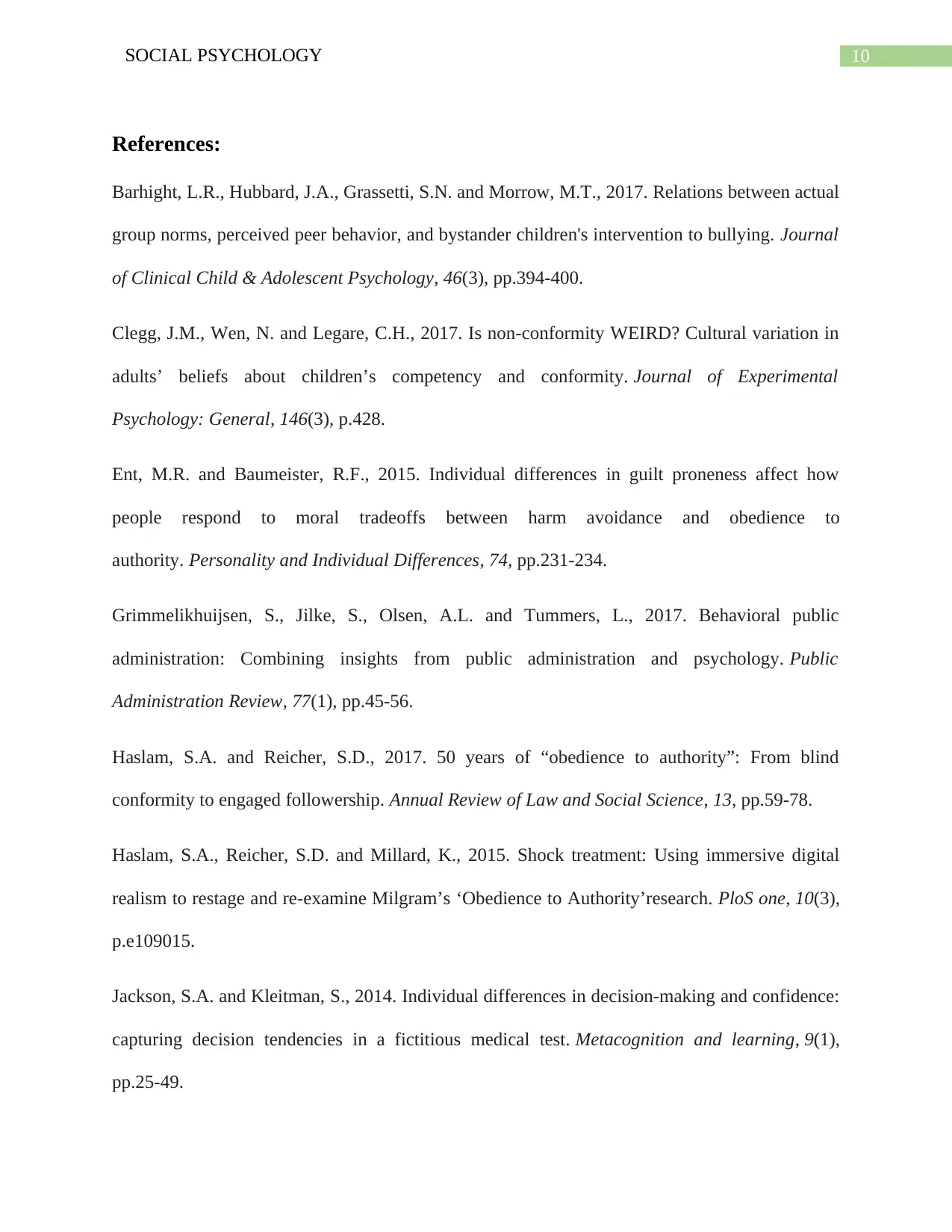
10SOCIAL PSYCHOLOGY
References:
Barhight, L.R., Hubbard, J.A., Grassetti, S.N. and Morrow, M.T., 2017. Relations between actual
group norms, perceived peer behavior, and bystander children's intervention to bullying. Journal
of Clinical Child & Adolescent Psychology, 46(3), pp.394-400.
Clegg, J.M., Wen, N. and Legare, C.H., 2017. Is non-conformity WEIRD? Cultural variation in
adults’ beliefs about children’s competency and conformity. Journal of Experimental
Psychology: General, 146(3), p.428.
Ent, M.R. and Baumeister, R.F., 2015. Individual differences in guilt proneness affect how
people respond to moral tradeoffs between harm avoidance and obedience to
authority. Personality and Individual Differences, 74, pp.231-234.
Grimmelikhuijsen, S., Jilke, S., Olsen, A.L. and Tummers, L., 2017. Behavioral public
administration: Combining insights from public administration and psychology. Public
Administration Review, 77(1), pp.45-56.
Haslam, S.A. and Reicher, S.D., 2017. 50 years of “obedience to authority”: From blind
conformity to engaged followership. Annual Review of Law and Social Science, 13, pp.59-78.
Haslam, S.A., Reicher, S.D. and Millard, K., 2015. Shock treatment: Using immersive digital
realism to restage and re-examine Milgram’s ‘Obedience to Authority’research. PloS one, 10(3),
p.e109015.
Jackson, S.A. and Kleitman, S., 2014. Individual differences in decision-making and confidence:
capturing decision tendencies in a fictitious medical test. Metacognition and learning, 9(1),
pp.25-49.
References:
Barhight, L.R., Hubbard, J.A., Grassetti, S.N. and Morrow, M.T., 2017. Relations between actual
group norms, perceived peer behavior, and bystander children's intervention to bullying. Journal
of Clinical Child & Adolescent Psychology, 46(3), pp.394-400.
Clegg, J.M., Wen, N. and Legare, C.H., 2017. Is non-conformity WEIRD? Cultural variation in
adults’ beliefs about children’s competency and conformity. Journal of Experimental
Psychology: General, 146(3), p.428.
Ent, M.R. and Baumeister, R.F., 2015. Individual differences in guilt proneness affect how
people respond to moral tradeoffs between harm avoidance and obedience to
authority. Personality and Individual Differences, 74, pp.231-234.
Grimmelikhuijsen, S., Jilke, S., Olsen, A.L. and Tummers, L., 2017. Behavioral public
administration: Combining insights from public administration and psychology. Public
Administration Review, 77(1), pp.45-56.
Haslam, S.A. and Reicher, S.D., 2017. 50 years of “obedience to authority”: From blind
conformity to engaged followership. Annual Review of Law and Social Science, 13, pp.59-78.
Haslam, S.A., Reicher, S.D. and Millard, K., 2015. Shock treatment: Using immersive digital
realism to restage and re-examine Milgram’s ‘Obedience to Authority’research. PloS one, 10(3),
p.e109015.
Jackson, S.A. and Kleitman, S., 2014. Individual differences in decision-making and confidence:
capturing decision tendencies in a fictitious medical test. Metacognition and learning, 9(1),
pp.25-49.
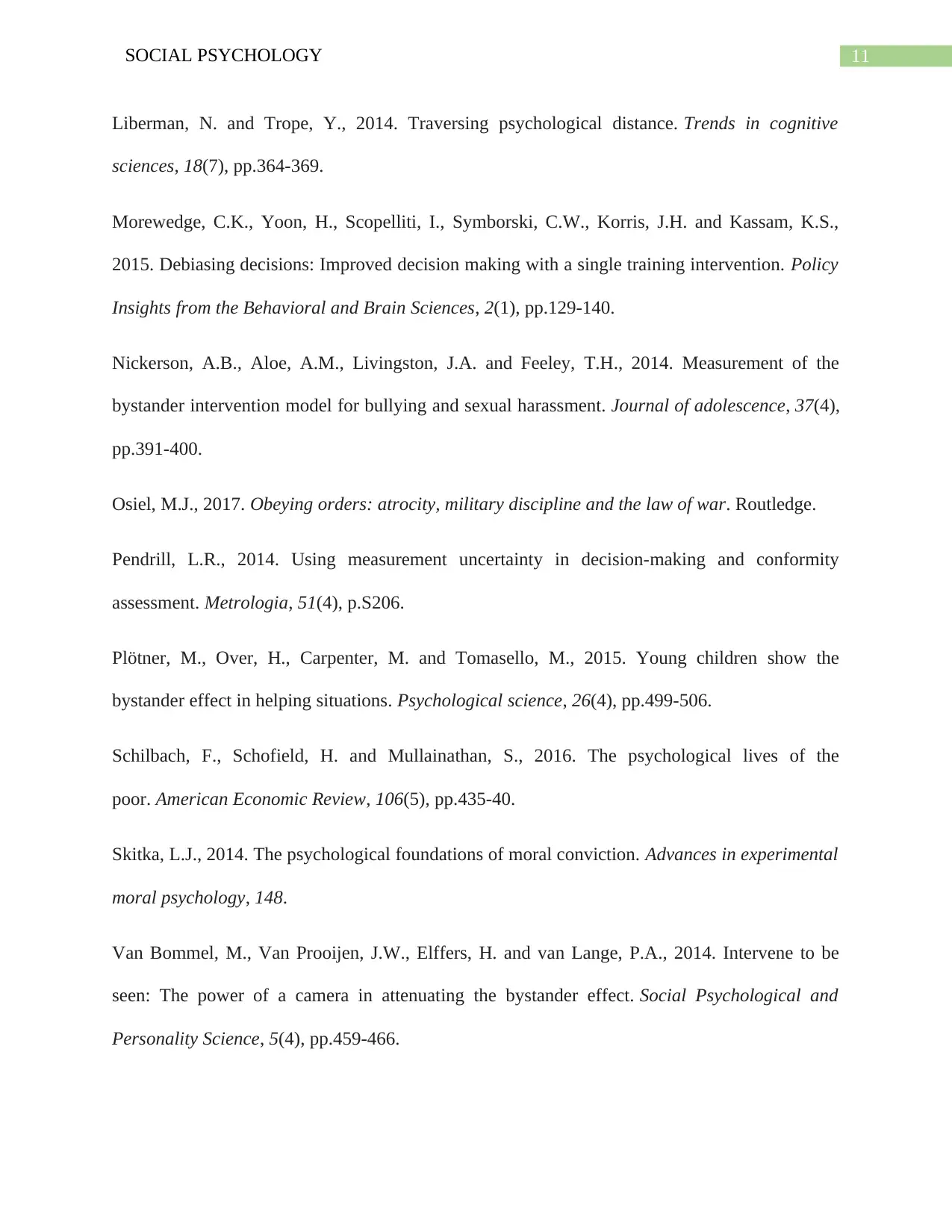
11SOCIAL PSYCHOLOGY
Liberman, N. and Trope, Y., 2014. Traversing psychological distance. Trends in cognitive
sciences, 18(7), pp.364-369.
Morewedge, C.K., Yoon, H., Scopelliti, I., Symborski, C.W., Korris, J.H. and Kassam, K.S.,
2015. Debiasing decisions: Improved decision making with a single training intervention. Policy
Insights from the Behavioral and Brain Sciences, 2(1), pp.129-140.
Nickerson, A.B., Aloe, A.M., Livingston, J.A. and Feeley, T.H., 2014. Measurement of the
bystander intervention model for bullying and sexual harassment. Journal of adolescence, 37(4),
pp.391-400.
Osiel, M.J., 2017. Obeying orders: atrocity, military discipline and the law of war. Routledge.
Pendrill, L.R., 2014. Using measurement uncertainty in decision-making and conformity
assessment. Metrologia, 51(4), p.S206.
Plötner, M., Over, H., Carpenter, M. and Tomasello, M., 2015. Young children show the
bystander effect in helping situations. Psychological science, 26(4), pp.499-506.
Schilbach, F., Schofield, H. and Mullainathan, S., 2016. The psychological lives of the
poor. American Economic Review, 106(5), pp.435-40.
Skitka, L.J., 2014. The psychological foundations of moral conviction. Advances in experimental
moral psychology, 148.
Van Bommel, M., Van Prooijen, J.W., Elffers, H. and van Lange, P.A., 2014. Intervene to be
seen: The power of a camera in attenuating the bystander effect. Social Psychological and
Personality Science, 5(4), pp.459-466.
Liberman, N. and Trope, Y., 2014. Traversing psychological distance. Trends in cognitive
sciences, 18(7), pp.364-369.
Morewedge, C.K., Yoon, H., Scopelliti, I., Symborski, C.W., Korris, J.H. and Kassam, K.S.,
2015. Debiasing decisions: Improved decision making with a single training intervention. Policy
Insights from the Behavioral and Brain Sciences, 2(1), pp.129-140.
Nickerson, A.B., Aloe, A.M., Livingston, J.A. and Feeley, T.H., 2014. Measurement of the
bystander intervention model for bullying and sexual harassment. Journal of adolescence, 37(4),
pp.391-400.
Osiel, M.J., 2017. Obeying orders: atrocity, military discipline and the law of war. Routledge.
Pendrill, L.R., 2014. Using measurement uncertainty in decision-making and conformity
assessment. Metrologia, 51(4), p.S206.
Plötner, M., Over, H., Carpenter, M. and Tomasello, M., 2015. Young children show the
bystander effect in helping situations. Psychological science, 26(4), pp.499-506.
Schilbach, F., Schofield, H. and Mullainathan, S., 2016. The psychological lives of the
poor. American Economic Review, 106(5), pp.435-40.
Skitka, L.J., 2014. The psychological foundations of moral conviction. Advances in experimental
moral psychology, 148.
Van Bommel, M., Van Prooijen, J.W., Elffers, H. and van Lange, P.A., 2014. Intervene to be
seen: The power of a camera in attenuating the bystander effect. Social Psychological and
Personality Science, 5(4), pp.459-466.
⊘ This is a preview!⊘
Do you want full access?
Subscribe today to unlock all pages.

Trusted by 1+ million students worldwide
1 out of 13
Your All-in-One AI-Powered Toolkit for Academic Success.
+13062052269
info@desklib.com
Available 24*7 on WhatsApp / Email
![[object Object]](/_next/static/media/star-bottom.7253800d.svg)
Unlock your academic potential
Copyright © 2020–2025 A2Z Services. All Rights Reserved. Developed and managed by ZUCOL.